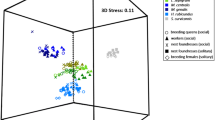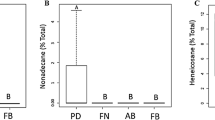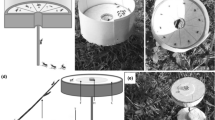Abstract
The relative contributions of heritable and environmentally acquired components of colony odor towards individual recognition are scarcely known in social insects. Larval food may affect cuticular profiles which in turn may serve as cues in the process of elimination of excess gynes characteristic of the eusocial stingless bees. In this study, we evaluated the contribution of larval food to cuticular profiles of stingless bee gynes and quantitatively tested if recognition (latency) from workers may be related to gyne chemotype and origin in the species Scaptotrigona pectoralis. Our results showed that the origin of food did not significantly affect the cuticular profiles of gynes, as larvae of the same origin reared on food from different colonies showed similar cuticular profiles at emergence. We suggest that overlapping over floral resources may account for the similarity in cuticular cues derived from food across experimental colonies. Additionally, workers showed similar latency time to first aggression towards gynes irrespectively of their chemotype and origin. Gyne’s mass had no effect on the aggressive response from workers either. We observed that gynes threatened aggressive workers which counteracted further aggression. Our results indicate that in stingless bees, cuticular hydrocarbons at emergence seem to have genetic origin and that gyne tolerance seems not related to cuticular chemical profiles. We suggest that cuticular cues may serve as caste labels for the identification of newly emerged gynes after which worker aggression towards them would elicit behavioral indicators of their fitness.
Significance Statement
We studied the effect of larval food on the cuticular profile of stingless bee gynes coupled with an evaluation of the effect of chemotype in gyne recognition by workers in Scaptotrigona. We used artificial methods of gyne rearing that avoid nest odor acquisition of newly emerged individuals so that the effect of food could be better analyzed on gynes reared on food of their own colony and a different one. The origin of larval food did not significantly affect the cuticular profiles of gynes and workers attacked gynes irrespective of their chemotype. Our results demonstrate that cuticular chemical profiles are explained by genetic origin and not larval diet and that workers’ aggressive responses to gynes are independent of gyne colony origin.

Similar content being viewed by others
References
Abdalla FC, Jones GR, Morgan ED, Cruz-Landim C (2003) Comparative study of the cuticular hydrocarbon composition of Melipona bicolor Lepeletier, 1836 (Hymenoptera, Meliponini) workers and queens. Genet Mol Res 2:191–199
Akino T, Yamamura K, Wakamura S, Yamaoka R (2004) Direct behavioral evidence for hydrocarbons as nestmate recognition cues in Formica japonica (Hymenoptera: Formicidae). Appl Entomol Zool 39:381–387
Amsalem E, Teal P, Grozinger CM, Hefetz A (2014) Precocene-I inhibits juvenile hormone biosynthesis, ovarian activation, aggression and alters sterility signal production in bumble bee (Bombus terrestris) workers. J Exp Biol 217:3178–3185
Arnold G, Quenet B, Cornuet JM, Masson C, De Schepper B, Estoup A, Gasul P (1996) Kin recognition in honeybees. Nature 379:498
Baptistella AR, Souza CCM, Santana WC, Egea SAE (2012) Techniques for the in vitro production of queens in stingless bees (Apidae, Meliponini). Sociobiol 59:297–310
Borges AA, Ferreira-Caliman MJ, Nascimento FS, Campos LAO, Tavares MG (2012) Characterization of cuticular hydrocarbons of diploid and haploid males, workers and queens of the stingless bee Melipona quadrifasciata. Insect Soc 59:479–486
Boulay R, Cerdá X, Simon T, Roldan M, Hefetz A (2007) Intraspecific competition in the ant Camponotus cruentatus: should we expect the ‘dear enemy’ effect? Anim Behav 74:985–993
Breed MD, Butler L, Stiller TM (1985) Kin discrimination by worker honey bees in genetically mixed groups. Proc Natl Acad Sci U S A 82:3058–3061
Breed MD, Williams KR, Fewell JH (1988) Comb wax mediates the acquisition of nest-mate recognition cues in honey bees. Proc Natl Acad Sci U S A 85:8766–8769
Breed MD, Abel P, Bleuze TJ, Denton SE (1990) Thievery, home ranges, and nestmate recognition in Ectatomma ruidum. Oecologia 84:117–121
Breed MD, Garry MF, Pearce AN, Hibbard BE, Bjostad LB, Page RE Jr (1995) The role of wax comb in honey bee nestmate recognition. Anim Behav 50:489–496
Buchwald R, Breed MD (2005) Nestmate recognition cues in the stingless bee Trigona fulviventris. Anim Behav 70:1331–1337
Buczhowski G, Kumar R, Suib SL, Silverman J (2005) Diet-related modification of cuticular hydrocarbon profiles of the Argentine ant, Linepithema humile, diminishes intercolony aggression. J Chem Ecol 31:829–843
Chaline N, Sandoz JC, Martin SJ, Ratnieks FLW, Jones GR (2005) Learning and discrimination of individual cuticular hydrocarbons by honey bees (Apis mellifera). Chem Senses 30:327–333
Cushman JH, Martinsen GD, Mazeroll AI (1988) Density dependent and size-dependent spacing of ant nests—evidence for intraspecific competition. Oecologia 77:522–525
Dani FR, Jones GR, Corsi S, Beard R, Pradella D, Turillazzi L (2005) Nestmate recognition cues in the honey bee: differential importance of cuticular alkanes and alkenes. Chem Senses 30:477–489
Downs SG, Ratnieks FLW (1999) Recognition of conspecifics by honeybee guards uses non-heritable cues acquired in the adult stage. Anim Behav 58:643–648
Eltz T, Brühl CA, van der Kaars S, Chey VK, Linsenmair KE (2001) Pollen foraging and resource partitioning of stingless bees in relation to flowering dynamics in a Southeast Asian tropical rainforest. Insect Soc 48:273–279
Engels W, Imperatriz-Fonseca VL (1990) Caste development, reproductive strategies and control of fertility in honey bees and stingless bees. In: Engels W (ed) Social insects: An evolutionary approach to castes and reproduction. Springer, USA, pp 167–230
Francis BR, Blanton WE, Littlefield JL, Nunamaker RA (1989) Hydrocarbons of the cuticle and hemolymph of the adult honey bee (Hymenoptera: Apidae). Ann Entomol Soc Am 82:486–494
Getz W, Page RE Jr (1991) Chemosensory kin-communication systems and kin recognition in honey bees. Ethology 87:298–315
Getz WM, Smith KB (1983) Genetic kin recognition: honey bees discriminate between full and half sisters. Nature 302:147–148
Hölldobler B, Wilson EO (1990) The ants. The Belknap Press of Harvard University Press, Cambridge
Hubbell SP, Johnson LK (1978) Comparative foraging behavior of six stingless bees exploiting a standardized resource. Ecology 59:1123–1136
Hurtado-Burillo M, Ruiz C, May-Itzá WDJ, Quezada-Eúan JJG, De La Rúa P (2013) Barcoding stingless bees: genetic diversity of the economically important genus Scaptotrigona in Mesoamerica. Apidologie 44:1–10
Imperatriz-Fonseca VL, Zucchi R (1995) Virgin queens in stingless bee (Apidae, Meliponinae) colonies: a review. Apidologie 26:231–244
Jarau S, van Veen JW, Aguilar I, Ayasse M (2009) Virgin queen execution in the stingless bee Melipona beecheii: the sign stimulus for worker attacks. Apidologie 40:496–507
Jutsum AR, Saunders TS, Cherrett JM (1979) Intraspecific aggression in the leaf-cutting ant Acromyrmex octospinosus. Anim Behav 27:839–844
Kärcher MH, Menezes C, Alves DA, Beveridge OS, Imperatriz-Fonseca VL, Ratnieks FLW (2013) Factors influencing survival duration and choice of virgin queens in the stingless bee Melipona quadrifasciata. Naturwissenschaften 100:571–580
Lahav S, Soroker V, Hefetz A, Vander Meer RK (1999) Direct behavioral evidence for hydrocarbons as ant recognition discriminators. Naturwissenschaften 86:246–249
Le Moli F, Mori A, Grasso DA (1992) Nestmate and conspecific non-nestmate recognition in Formica cunnicularia Latr.: the effect of diet difference. In: Billen J (ed) Biology and evolution of social insects. Leuven University Press, Leuven, pp 161–165
Leonhardt SD, Jung LM, Schmitt T, Blüthgen N (2009) Terpenoids tame aggressors: role of chemicals in stingless bee communal nesting. Behav Ecol Sociobiol 64:1415–1423
Liang D, Silverman J (2000) You are what you eat: diet modifies cuticular hydrocarbons and nestmate recognition in the Argentine ant, Linepithema humile. Naturwissenschaften 87:412–416
Martin SJ, Carruthers JM, Williams PH, Drijfhout FP (2010) Host specific social parasites (Psithyrus) indicate chemical recognition system in bumblebees. J Chem Ecol 36:855–863
Martin SJ, Shemilt S, Drijfhout FP (2012) Effect of time on colony odour stability in the ant Formica exsecta. Naturwissenschaften 99:327–331
Martin SJ, Vitikainen E, Shemilt S, Drijfhout FP, Sundström L (2013) Sources of variation in cuticular hydrocarbons in the ant Formica exsecta. J Chem Ecol 39:1415–1423
Menezes C, Vollet-Neto A, Imperatriz-Fonseca VL (2013) An advance in the in vitro rearing of stingless bee queens. Apidologie 44:491–500
Moo-Valle H, Quezada-Euan JJG, Wenseleers T (2001) The effect of food reserves on the production of sexual offspring in the stingless bee Melipona beecheii (Apidae, Meliponini). Insect Soc 48:398–403
Nagamitsu T, Momose K, Inoue T, Roubik DW (1999) Preferences in flower visits and partitioning in pollen diets of stingless bees in an Asian tropical rain forest. Res Popul Ecol 41:195–202
Nascimento DL, Nascimento FS (2012) Acceptance threshold hypothesis is supported by chemical similarity of cuticular hydrocarbons in a stingless bee, Melipona asilvai. J Chem Ecol 38:1432–1440
Nunes TM, Nascimento FS, Turatti IC, Lopes NP, Zucchi R (2008) Nestmate recognition in a stingless bee: does the similarity of chemical cues determine guard acceptance? Anim Behav 75:1165–1171
Nunes TM, Turatti IC, Lopes NP, Zucchi R (2009a) Chemical signals in the stingless bee, Frieseomelitta varia, indicate caste, gender, age and reproductive status. J Chem Ecol 35:1172–1180
Nunes TM, Turatti IC, Mateus S, Nascimento FS, Lopes NP, Zucchi R (2009b) Cuticular hydrocarbons in the stingless bee Schwarziana quadripunctata (Hymenoptera, Apidae, Meliponini): differences between colonies, castes and age. Genet Mol Res 8:589–595
Nunes TM, Mateus S, Turatti IC, Morgan E, Zucchi R (2011) Nestmate recognition in the stingless bee Frieseomelitta varia (Hymenoptera, Apidae, Meliponini): sources of chemical signals. Anim Behav 81:463–467
Page RE Jr, Metcalf RA, Erickson EH Jr, Lampman RL (1991) Extractable hydrocarbons and kin recognition in the honey bee (Apis mellifera L.). J Chem Ecol 17:745–756
Quezada-Euán JJG (2005) Biología y uso de las abejas nativas sin aguijón de la Península de Yucatán, México (Hymenoptera: Meliponini). Universidad Autónoma de Yucatán, Merida
Quezada-Euán JJG, López-Velasco A, Pérez-Balam J, Moo-Valle H, Velazquez-Madrazo A, Paxton RJ (2011) Body size differs in workers produced across time and is associated with variation in the quantity and composition of larval food in Nannotrigona perilampoides (Hymenoptera, Meliponini). Insect Soc 58:31–38
Quezada-Euán JJG, Ramírez J, Eltz T, Pokorny T, Medina R, Monsreal R (2013) Does sensory deception matter in eusocial obligate food robber systems? A study of Lestrimelitta and stingless bee hosts. Anim Behav 85:817–823
Ramalho M (1990) Foraging by stingless bees of the genus Scaptotrigona (Apidae, Meliponinae). J Apic Res 29:61–67
Richard FJ, Hunt JH (2013) Intracolony chemical communication in social insects. Insect Soc 60:275–291
Richard FJ, Hefetz A, Christides JP, Errard C (2004) Food influence on colonial recognition and chemical signature between nestmates in the fungus-growing ant Acromyrmex subterraneus subterraneus. Chemoecology 14:9–16
Richard FJ, Poulsen M, Hefetz A, Errard C, Nash DR, Boomsma JJ (2007) The origin of the chemical profiles of fungal symbionts and their significance for nestmate recognition in Acromyrmex leaf-cutting ants. Behav Ecol Sociobiol 61:1637–1649
Rojas MG, Werle C, Cottrell N, Morales-Ramos JA (2005) Changes in ratios of four cuticular hydrocarbons in Formosan subterranean termite workers (Coptotermes formsanus) (Isoptera:Rhinotermitidae) due to diet. Sociobiol 46:131–140
Septanil MPB, Mateus S, Turatti IT, Nunes TM (2012) Mixed colonies of two species of congeneric stingless bees (Hymenoptera: Apinae, Meliponini) display environmentally-acquired and endogenously-produced recognition signals. Physiol Entomol 37:72–80
Shpigler H, Amsalem E, Huang ZY, Cohen M, Siegel AJ et al (2014) Gonadotropic and physiological functions of juvenile hormone in bumblebee (Bombus terrestris) workers. PLoS ONE 9, e100650
Silverman J, Liang D (2001) Colony disassociation following diet partitioning in a unicolonial ant. Naturwissenschaften 88:73–77
Slaa EJ (2006) Spatial nesting patterns in a Neotropical stingless bee community: do bees compete for food? Proc Neth Entomol Soc Meet 17:71–78
Sommeijer MJ, De Bruijn LLM, Meeuwsen F (2003) Reproductive behaviour of stingless bees: solitary gynes of Melipona favosa (Hymenoptera: Apidae, Meliponini) can penetrate existing nests. Entomologische Berichten 63:31–35
Sorvari J, Theodora P, Turillazzi S, Hakkarainen H, Sundström L (2008) Food resources, chemical signaling, and nestmate recognition in the ant Formica aquilonia. Behav Ecol 19:441–447
SPSS, Inc (2006) SPSS for Windows version 15. SPSS, Inc, Chicago
Tabachnik BG, Fidell LS (1996) Using multivariate statistics. Harper Collins College Publishers, New York
Tarpy DR, Gilley DC (2004) Group decision making during queen production in colonies of highly eusocial bees. Apidologie 35:207–216
Toth AL, Tooker JF, Radhakrishnan S, Minard R, Henshaw MT, Grozinger CM (2014) Shared genes related to aggression, rather than chemical communication, are associated with reproductive dominance in paper wasps (Polistes metricus). BMC Genomics 15:75
Van Oystaeyen A, Araujo-Alves D, Caliari-Oliveira R, Lima-do Nascimento D, Nascimento S-d, Billen J, Wenseleers T (2013) Sneaky Queens in Melipona bees selectively detect and infiltrate queenleess colonies. Anim Behav 86:603–609
van Zweden JS, D’Ettorre P (2010) Nestmate recognition in social insects and the role of hydrocarbons. In: Blomquist GJ, Bagnères AG (eds) Insect Hydrocarbons: Biology. Biochemistry and Chemical Ecology. Cambridge University Press, Cambridge, pp 222–243
Vander Meer RK, Morel L (1998) Nestmate recognition in ants. In: Vander Meer RK, Breed M, Espelie KE, Winston M (eds) Pheromone communication in social insects. Westview Press, Boulder, pp 79–103
Velthuis HHW, Cortopassi-Laurino M, Pereboom Z, Imperatriz-Fonseca VL (2003) Speciation, development, and the conservative egg of the stingless bee genus Melipona. Proc Exper Appl Entomol NEV Amsterdam 14:53–57
Wehner R, Srinivasan MV (2003) Path integration in insects. In: Jeffery KJ (ed) The neurobiology of spatial behaviour. Oxford University Press, Oxford, pp 9–30
Wenseleers T, Hart AG, Ratnieks FLW, Quezada-Euan JJG (2004) Queen execution and caste conflict in the stingless bee Melipona beecheii. Ethology 110:725–736
Wenseleers T, Alves DA, Francoy TM, Billen J, Imperatriz-Fonseca VL (2011) Intraspecific queen parasitism in a highly eusocial bee. Biol Lett 7:173–176
Wiernasz DC, Cole BJ (1995) Spatial distribution of Pogonomyrmex occidentalis: recruitment, mortality and overdispersion. J Animal Ecol 64:519–527
Acknowledgements
We are thankful to two anonymous reviewers who provided valuable comments for the improvement of this manuscript. Project SEP-CONACyT 103341 “Conservación de las abejas sin aguijón de México” to JJGQE provided financial support. EG received a CONACyT grant for her MSc degree.
Author information
Authors and Affiliations
Corresponding author
Additional information
Communicated by W. T. Wcislo
Electronic supplementary material
Below is the link to the electronic supplementary material.
ESM 1
Table S1 Relative proportions of cuticular hydrocarbons (in percent) found in S. pectoralis gynes. RT, retention time; RI, retention index. A dash denotes that the analyte was not identified in the trial sample. The values in brackets represent standard deviations. Table S2 Principal component analysis for saturated (alkanes) and unsaturated (alkenes) cuticular hydrocarbons in S. pectoralis gynes. Biological significance of analytes to each component was interpreted from factor loadings with absolute values > 0.7 (in bold). Table S3 Principal component coefficients used to calculate sample scores (DOCX 27 kb)
ESM 2
Figure S1 Diagram presenting the experimental set up used to investigate the effect of larval food and the origin of larvae on gyne cuticular profile and recognition. Figure S2 Chromatogram of cuticular extracts of S. pectoralis gynes. Asterisks indicate the position of the obtained alkenes (Table 1). (DOC 408 kb)
Rights and permissions
About this article
Cite this article
Gutiérrez, E., Ruiz, D., Solís, T. et al. Does larval food affect cuticular profiles and recognition in eusocial bees? a test on Scaptotrigona gynes (Hymenoptera: Meliponini). Behav Ecol Sociobiol 70, 871–879 (2016). https://doi.org/10.1007/s00265-016-2109-z
Received:
Revised:
Accepted:
Published:
Issue Date:
DOI: https://doi.org/10.1007/s00265-016-2109-z




